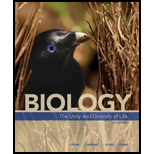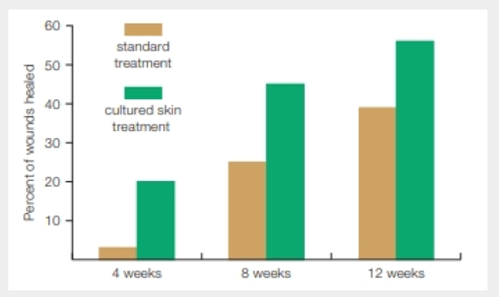
Concept explainers
Cultured Skin for Healing Wounds Diabetes is a disorder in which the blood sugar level is not properly controlled. Among other effects, it reduces blood flow to the lower legs and feet. As a result, about 3 million diabetes patients have ulcers (open wounds that do not heal) on their feet. Each year, about 80,000 require amputations.
Several companies provide cultured cell products designed to promote the healing of diabetic foot ulcers. FIGURE 31.15 shows the results of a clinical experiment that tested the effect of one such cultured skin product versus standard treatment for diabetic foot wounds. Patients were randomly assigned to either the experimental treatment group or the control group, and their progress was monitored for 12 weeks.

FIGURE 31.15 Treatment of diabetic food ulcers. Results of a multicenter study of the effects of standard treatment versus use of a cultured cell product for diabetic foot ulcers. Bars show the percentage of foot ulcers that had completely healed.
What percentage of wounds had healed at 8 weeks when treated the standard way? When treated with cultured skin?
To determine: The percentage of wounds healed at 8 weeks when treated with standard treatment and when treated with cultured skin treatment.
Concept introduction: Diabetes is a group of disorders in which the body possesses high blood sugar level. This type of disease can lead to foot ulcers due to the decreased flow of blood into the legs and feet. They are caused when the nerves are damaged, which can lead to painless wounds that can ultimately cause ulcers that are the wounds that do not heal. Some experiments were conducted in order to heal the wounds. The patients were randomly treated using standard treatment and cultured skin treatment.
Explanation of Solution
Refer to Fig. 31.15, “Treatment of diabetic food ulcers”, in the textbook. The bar graph shows an experiment that was conducted to heal the wounds of diabetic foot ulcers. It involved the participation of many patients who were randomly treated using standard treatment and cultured skin treatment, and their improvement was observed for about 12 weeks. According to the observations, a bar graph was plotted, which shows the percentage of wounds healed versus the number of weeks. Each bar represents the percentage of foot ulcers that had healed completely. The orange color indicates the standard treatment, and green color indicates the cultured skin treatment.
The percentage of wounds healed at 8 weeks when treated with standard treatment was 24%. The percentage of wounds healed at 8 weeks when treated with cultured skin treatment was 45 %. The cultured skin treatment had a greater percentage when compared with the standard treatment.
Want to see more full solutions like this?
Chapter 31 Solutions
Biology: The Unity and Diversity of Life (MindTap Course List)
Additional Science Textbook Solutions
Organic Chemistry
Biological Science (6th Edition)
Genetics: From Genes to Genomes
Campbell Biology in Focus (2nd Edition)
Campbell Essential Biology (7th Edition)
- Genes at loci f, m, and w are linked, but their order is unknown. The F1 heterozygotes from a cross of FFMMWW x ffmmww are test crossed. The most frequent phenotypes in the test cross progeny will be FMW and fmw regardless of what the gene order turns out to be. What classes of testcross progeny (phenotypes) would be least frequent if locus m is in the middle? What classes would be least frequent if locus f is in the middle? What classes would be least frequent if locus w is in the middle?arrow_forward1. In the following illustration of a phospholipid... (Chemistry Primer and Video 2-2, 2-3 and 2-5) a. Label which chains contain saturated fatty acids and non-saturated fatty acids. b. Label all the areas where the following bonds could form with other molecules which are not shown. i. Hydrogen bonds ii. Ionic Bonds iii. Hydrophobic Interactions 12-6 HICIH HICIH HICHH HICHH HICIH OHHHHHHHHHHHHHHHHH C-C-C-C-C-c-c-c-c-c-c-c-c-c-c-c-C-C-H HH H H H H H H H H H H H H H H H H H HO H-C-O H-C-O- O O-P-O-C-H H T HICIH HICIH HICIH HICIH HHHHHHH HICIH HICIH HICIH 0=C HIC -C-C-C-C-C-C-C-C-CC-C-C-C-C-C-C-C-C-H HHHHHHHHH IIIIIIII HHHHHHHH (e-osbiv)arrow_forwardAnswer this as a dental assistant studentarrow_forward
- buatkan judul skripsi tentang parasitologi yang sedang trendinharrow_forwardDental assistantarrow_forwardO Macmillan Learning Glu-His-Trp-Ser-Gly-Leu-Arg-Pro-Gly The pKa values for the peptide's side chains, terminal amino groups, and carboxyl groups are provided in the table. Amino acid Amino pKa Carboxyl pKa Side-chain pKa glutamate 9.60 2.34 histidine 9.17 1.82 4.25 6.00 tryptophan 9.39 2.38 serine 9.15 2.21 glycine 9.60 2.34 leucine 9.60 2.36 arginine 9.04 2.17 12.48 proline 10.96 1.99 Calculate the net charge of the molecule at pH 3. net charge at pH 3: Calculate the net charge of the molecule at pH 8. net charge at pH 8: Calculate the net charge of the molecule at pH 11. net charge at pH 11: Estimate the isoelectric point (pl) for this peptide. pl:arrow_forward
- Biology Questionarrow_forwardThis entire structure (Pinus pollen cone) using lifecycle terminology is called what?arrow_forwardThis entire structure using lifecycle terminology is called what? megastrobilus microstrobilus megasporophyll microsporophyll microsporangium megasporangium none of thesearrow_forward
- How much protein should Sarah add to her diet if she gets pregnant? Sarah's protein requirements during pregnancy would be higher. See Hint B2. During calculations, use numbers rounded to the first decimal place. In your answer, round the number of grams to the nearest whole number. _______ g ?arrow_forwardC MasteringHealth MasteringNu X session.healthandnutrition-mastering.pearson.com/myct/itemView?assignment ProblemID=17396422&attemptNo=1&offset=prevarrow_forwardMost people, even those who exercise regularly at low to average intensity (1 hour at the gym or a 2- to 3-mile walk several times per week), do not need an increased protein intake. What would be the protein needs of a man named Josh who exercises moderately and is the same age and size as Wayne? Josh is 5 ft, 8 in tall and weighs 183 lb. Round the number of grams to the nearest whole number. During calculations, use numbers rounded to the first decimal place. Because protein requirement is a range, please enter two numbers: lower and upper range values, respectively. Separate the lower and upper range values, in that order, by a comma. ___, ___ g ?arrow_forwardarrow_back_iosSEE MORE QUESTIONSarrow_forward_ios
 Biology: The Dynamic Science (MindTap Course List)BiologyISBN:9781305389892Author:Peter J. Russell, Paul E. Hertz, Beverly McMillanPublisher:Cengage Learning
Biology: The Dynamic Science (MindTap Course List)BiologyISBN:9781305389892Author:Peter J. Russell, Paul E. Hertz, Beverly McMillanPublisher:Cengage Learning Biology 2eBiologyISBN:9781947172517Author:Matthew Douglas, Jung Choi, Mary Ann ClarkPublisher:OpenStax
Biology 2eBiologyISBN:9781947172517Author:Matthew Douglas, Jung Choi, Mary Ann ClarkPublisher:OpenStax BiochemistryBiochemistryISBN:9781305577206Author:Reginald H. Garrett, Charles M. GrishamPublisher:Cengage Learning
BiochemistryBiochemistryISBN:9781305577206Author:Reginald H. Garrett, Charles M. GrishamPublisher:Cengage Learning Human Heredity: Principles and Issues (MindTap Co...BiologyISBN:9781305251052Author:Michael CummingsPublisher:Cengage Learning
Human Heredity: Principles and Issues (MindTap Co...BiologyISBN:9781305251052Author:Michael CummingsPublisher:Cengage Learning





